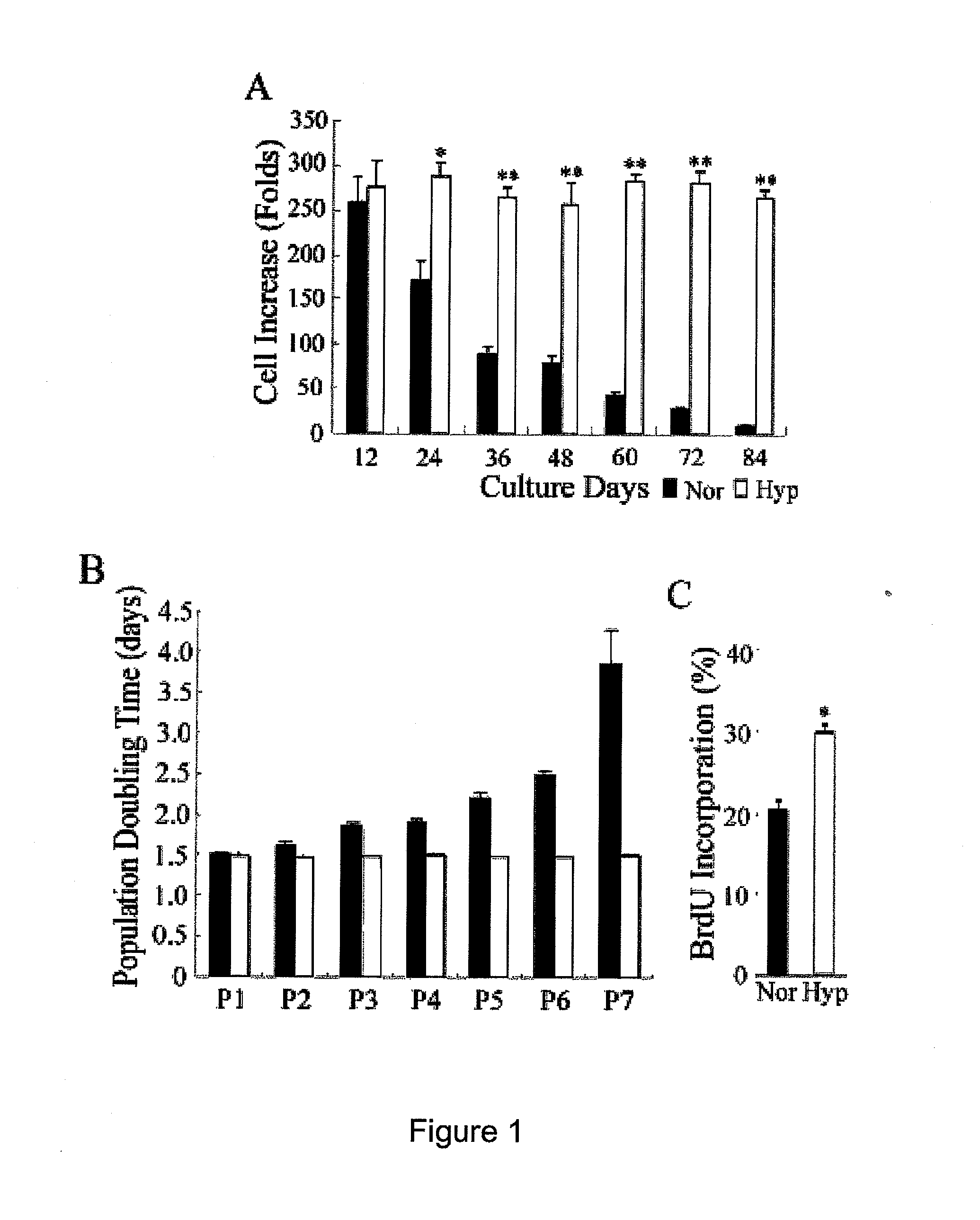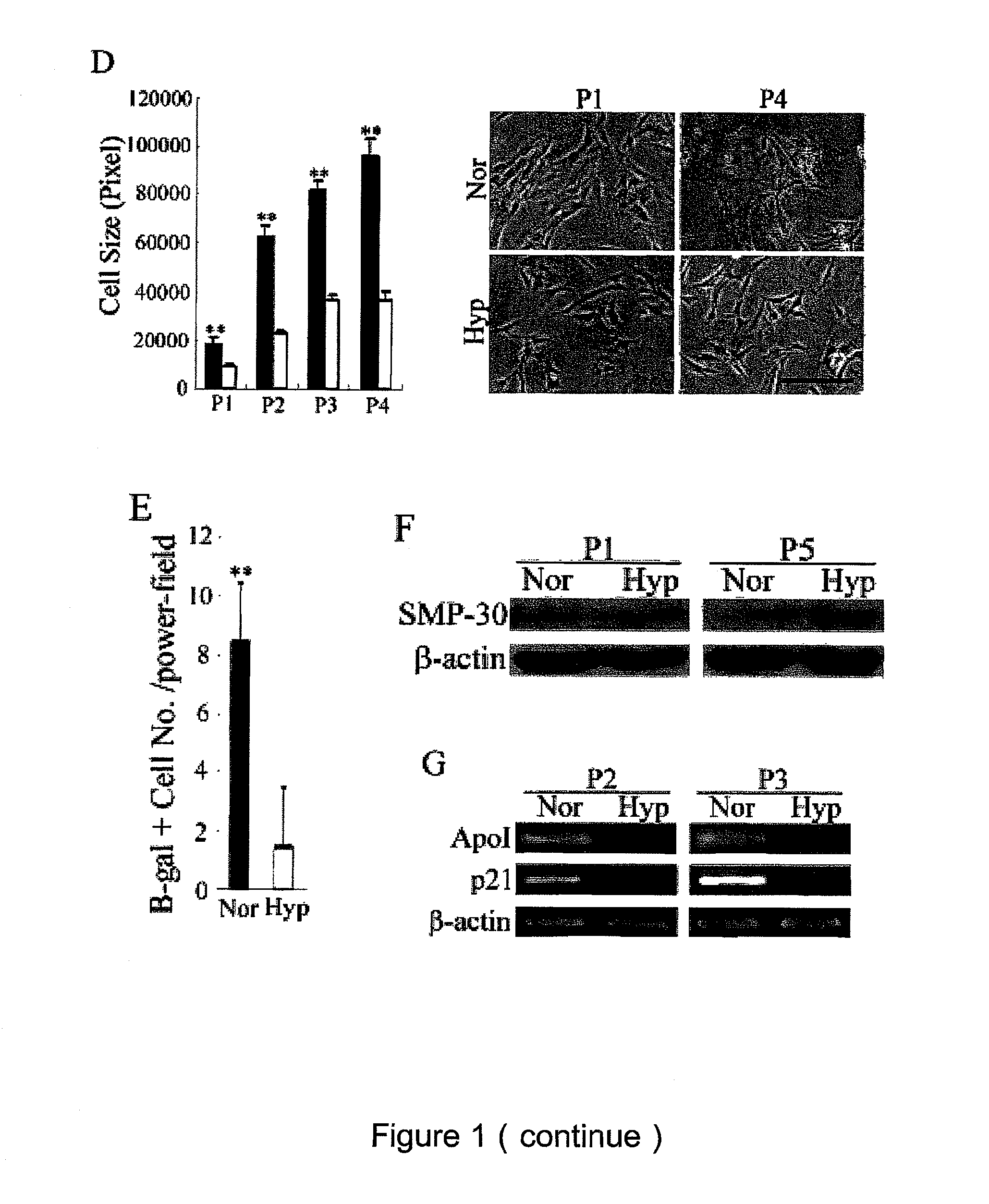Method for expanding mesenchymal stem cells in low-density and hypoxic culture
a mesenchymal stem cell and low-density culture technology, applied in the field of mesenchymal stem cell expansion in low-density and hypoxic culture, can solve the problems of hindering clinical applications of mscs, difference in stem cell properties, and remarkable difference in proliferation and differentiation capacity, so as to preserve early stem cell properties and maintain normal karyotyping
- Summary
- Abstract
- Description
- Claims
- Application Information
AI Technical Summary
Benefits of technology
Problems solved by technology
Method used
Image
Examples
example
Example 1
Hypoxic Culture Increases Expansion Efficiency and Decreases in Senescence
[0021]To rapidly expand MSCs with maintained properties, we first analyzed the expansion efficiency at a variety of seeding densities. Primary MSCs from three normal human volunteers were obtained from the Tulane Center for Distribution of Adult Stem Cells (wolfe@tulane.edu) and were prepared as described previously (Sekiya et al., Stem Cells 20, 530-541, 2002). The cells were seeded at 50 to 4×103 cells per cm2 and grown in complete culture medium [CCM: α-MEM (α-minimal essential medium; Gibco-BRL, Gaithersburg, Md.), supplemented with 16.6% fetal to bovine serum (FBS), 100 units / mL penicillin, 100 μg / mL streptomycin, and 2 mM L-glutamine] in plastic culture dish with medium change twice per week.
TABLE 1Expansion information for different seeding densities (representative dataof MSCs from one dornor)Pas-Cell numberExpected cellSub-sages increasenumberSeedingcultureforfor each increase for Ratio toden...
example 2
Hypoxic Culture Increases Stemness of Mesenchymal Stem Cells
[0025]In this example, the expansion insults on the stem cell properties of MSCs under normoxic and hypoxic conditions were examined. Cells under both conditions had the same profiles of surface CD markers; they are consistently positive for CD44, CD73, CD90, 105 and CD166, putative markers of MSCs, but negative for CD34 and CD133, the markers of haematopoietic stem cells, and CD45, the marker of haematopoietic cells (FIG. 2A).
[0026]Stemness of MSCs could be assayed by the potential to differentiate along osteogenic, adipogenic and chondrogenic lineages. For in vitro differentiation into osteoblasts, adipocytes and chondrocytes, cells were induced in osteogenic induction medium [OIM: DMEM-LG supplemented with 10% FBS, 50 μg / mL ascorbate-2 phosphate), 10−8 M dexamethasone and 10 mM β-glycerophosphate], adipogenic induction medium [AIM: DMEM-LG supplemented with 10% FBS, 50 μg / mL ascorbate-2 phosphate, 10−7 M dexamethasone, 5...
example 3
Hypoxic Culture or HIF-Twist Bypasses Senescence and Increases Stemness by Suppressing p21 Expression
[0028]To clarify the anti-senescence effects of hypoxic culture, we compared MSC proliferation and apoptosis between normoxic and hypoxic cultures by analyzing the cell cycle phase distribution. FACS analysis of hypoxic cells revealed a marked reduction in cells in the G0 / G1 phase and a compensatory increase in cells in S and G2 / M phases compared with normoxic cells (FIG. 4A), suggesting hypoxic culture increased cell proliferation by modulating cell cycle entry. In addition, there was only a very small population of cells in the sub-G1 phase of both the hypoxic and normoxic cells (data not shown), suggesting cell apoptosis is not the main aspect hypoxic culture mediates to resist replicative senescence.
[0029]Because cell cycle regulatory proteins and their inhibitors are involved in to cellular senescence of human fibroblasts (McConnell et al., Curr Biol 8, 351-354, 1998; Stein et a...
PUM
| Property | Measurement | Unit |
|---|---|---|
| density | aaaaa | aaaaa |
| cell density | aaaaa | aaaaa |
| concentration | aaaaa | aaaaa |
Abstract
Description
Claims
Application Information
 Login to View More
Login to View More - R&D
- Intellectual Property
- Life Sciences
- Materials
- Tech Scout
- Unparalleled Data Quality
- Higher Quality Content
- 60% Fewer Hallucinations
Browse by: Latest US Patents, China's latest patents, Technical Efficacy Thesaurus, Application Domain, Technology Topic, Popular Technical Reports.
© 2025 PatSnap. All rights reserved.Legal|Privacy policy|Modern Slavery Act Transparency Statement|Sitemap|About US| Contact US: help@patsnap.com



